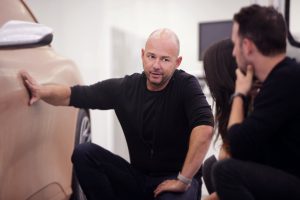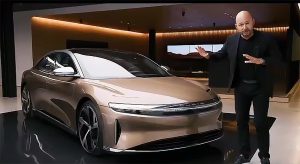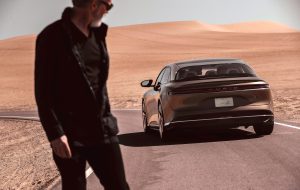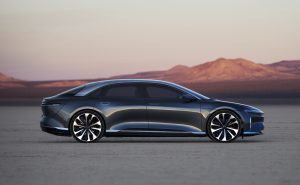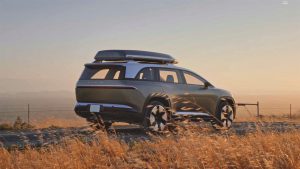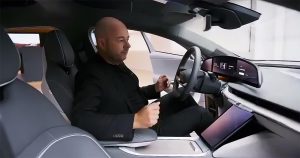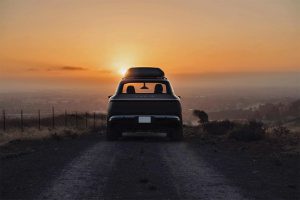A quick look at the resume of Lucid’s design chief Derek Jenkins and you recognize one of the auto industry’s hot shots of design. Since graduating from the prestigious Art Center College of Design, he has helped a handful of top brands craft some of the most solid products of recent years, including the award-winning 2016 Mazda MX-5 Miata. Jenkins has also worked for Audi, covering a broad range of products, from the little A2 to the flagship A8, as well as down-market sibling Volkswagen.
In 2015, he took what many saw as a risky detour, signing in with California-based electric vehicle start-up Atieva. It was one of a wave of EV wannabes, many of which have since folded. But, the now renamed Lucid Motors appears positioned to have a serious shot at carving out its own niche, perhaps even giving chase to the dominant electric vehicle player, Tesla.
Lucid this week formally unveiled its first production model, the Lucid Air, and Jenkins spoke by Zoom in a one-on-one conversation with TheDetroitBureau.com editor and publisher Paul A. Eisenstein.
(Q&A: Lucid CEO Peter Rawlinson.)
TheDetroitBureau: Since Lucid was formed nearly six years ago we have seen a lot of EV startups come and go. There were a lot of skeptics about whether you would even make it to market, as well.
Derek Jenkins: Truthfully, this has taken a long time, and longer than we would have liked. But it’s allowed us to really refine the technology and refine the car. That’s the way we operate. (And) it’s not just a car we’re building. We have to get a team off the ground, we had to go out and do a lot of fundraising. We had the financial side and the effort that went into the factory. Now we have to get the retail and distribution program in line. It’s taken longer than we hoped but that ties to the enormity of the process.
TDB: You’ve had a lot of experience with mainstream automakers (including Audi, Volkswagen and Mazda) before joining Lucid. From a design perspective, how is this different from what you’d done before?
Jenkins: That’s really the core reason I took the leap of faith and made the career shift to a project like this. (We are) much more entrepreneurial, being able to work across a whole range of aspects within Lucid, able to help develop the design DNA, the brand DNA, the visual language and the look and feel across the whole company.
You don’t get those opportunities when you’re in a big company. When you work for a company like Ford, VW, BMW, you have more people in design than you have in our entire organization. What’s great is that a very small group of people, less than I can count on one hand, are basically making all the decisions about what goes into the product. We’re not designing by committee.
TDB: In a presentation on Lucid, one of the key points was that you don’t have the typical silos, say, between engineering and design and manufacturing.
Jenkins: it’s just tremendous because the joined up thinking and decision making between design and engineering is really seamless. And it’s really hard to get that in a in a big, traditional organization.
TDB: From a design perspective, how is it different working on an electric vehicle using a skateboard platform compared to a conventional vehicle?
Designing an electric car opens up a whole new world in terms proportion, interior space, vehicle dimensions and more, Jenkins noted.
Jenkins: Going to electrification opens up a bunch of possibilities with respect to proportion, interior package space, vehicle dimensions. There’s a huge opportunity to take a real benefit from the miniaturization of components and how you lay those out. On the flip side, trying to create an electric vehicle that gets tremendous range requires a big commitment towards aerodynamics. And aerodynamics is a science, but it also has a bit of magic (that is) different with every project.
We’re not adhering to the existing size segmentation logic derived from internal combustion. It doesn’t add up anymore because our motors are small but powerful, changing the whole format of size on the outside versus space on the inside.
Going electric allowed us to us to keep the car low and fairly compact, with a long, sleek cabin, which is great for aerodynamics. The rest is designing to minimize air disruption: no big grilles, not a lot of the scoops and holes that are common today (on cars with internal combustion engines). It’s a form-follows-function approach, but it also looks elegant and expensive.
(Lucid Air to offer biggest battery pack of any EV — and longest range.)
TDB: A lot has changed since Lucid was founded, notably the big switch from passenger cars to SUVs and crossovers. In retrospect, should you have started with a utility vehicle, rather than a sedan?
Jenkins: It’s a great question. We talked about sedans. We talked about SUVs. We talked about pickup trucks in 2015. Ultimately, we knew the primary goal with the first product was to define Lucid as a brand. We knew the first product had be a stellar new benchmark for electrification in areas of range, performance, aesthetics and luxury. The sedan format is typically lower and smaller and lighter, more sleek and definitely more aerodynamic, definitely better for road handling and road comfort. So, it just became the logical format to focus on for the first go. Obviously, we’re going to follow on with a crossover for the second product.
TDB: Even with the sedan you haven’t sacrificed room, especially for cargo. Your frunk (front trunk) is twice the size of what the best the competition offers and not much smaller than most trunks.
Jenkins: Everybody wants a ton of space. And, I think, in our case a great deal of attention focused on the backseat and also a tremendous amount of cargo space. The frunk is just like a bonus room.
TDB: What can you tell us about your planned SUV, the Lucid Gravity?
Jenkins: We have so much focus on efficiency, range, performance and, of course, interior space. It’ll follow all those (requirements). I think there’s still a big opportunity to define is an SUV/crossover that takes full advantage of electrification and has a priority on efficiency and formance and space. Like sedans, (today’s) SUV format is dictated by the internal combustion architecture. I can say that our next product will take that to another level.
TDB: Suddenly, everyone seems to want to build electric pickups. Could that be in Lucid’s future?
Jenkins: Yeah, it goes without saying. I mean, we’ve already done a lot of long-term planning for our second platform and our third, as well, looking 10 years into the future. And we’re keenly aware of where the sales volume exists today in North America and the rest of the world. (A pickup) is certainly in the discussion.
TDB: We’re also seeing some companies push into sci-fi territory with designs like the Canoo or the Toyota e-Palette. Could Lucid come up with something like those people movers for use in e-mobility services?
Jenkins: Electrification, with the simplicity of the platform and miniaturization (of components), is going to enable some really neat new kinds of vehicle formats. I love vans. I have a Eurovan as a personal vehicle. So I love the idea. We’re open to a lot of different things. It’s all on the table right now in our long-term thinking.
(Lucid starts taking $1,000 deposits for its new Air EV.)
TDB: Let me turn to Tesla as wrap up. They’re the 800-pound gorilla of electrification. Do they frighten you? Inspire you?
Jenkins: It goes without question we all have tremendous respect for Tesla and what they’ve achieved helping accelerate the transition towards sustainable mobility in such a short period of time. We have a lot of Tesla people. CEO Peter Rawlinson is the most well known. But, as we look at the transition to electrification, it’s just begun. Tesla has a certain brand and a certain approach and why shouldn’t we have a shot at being very, very successful when the market (for EVs) is only 2% right now? Our mission is to accelerate the transition. Tons of respect for Tesla but we’re going to give it our own shot and do the very best we can to be positioned at the very top of this transition.
For GREAT deals on a new or used Harley check out Old Town Temecula Harley-Davidson TODAY!
